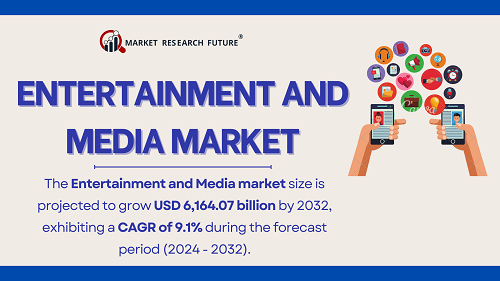Entertainment and Media Market Size, Share & Trends | Growth [2032]
Entertainment and Media Market Size, Share & Trends | Growth [2032]

Entertainment and Media Market Overview:
The global entertainment and media market is undergoing a dynamic transformation driven by rapid advancements in digital technology, shifting consumer preferences, and the rise of new media formats. Spanning various sectors like television, film, music, gaming, and digital content, this market is influenced heavily by trends in streaming, mobile accessibility, and social media engagement. The Entertainment and Media market size is projected to grow from USD 3,070.92 billion in 2024 to USD 6,164.07 billion by 2032, exhibiting a compound annual growth rate (CAGR) of 9.1% during the forecast period (2024 – 2032). Estimated to grow steadily over the coming years, the entertainment and media sector is embracing innovations such as virtual reality (VR), augmented reality (AR), and artificial intelligence (AI), which enhance user experiences and engagement. As consumers increasingly seek immersive and personalized experiences, media companies are investing in these technologies, expanding market opportunities and diversifying content offerings to cater to a broad audience.
Get a sample PDF of the report at –
https://www.marketresearchfuture.com/sample_request/7773
Competitive Analysis:
The entertainment and media market is highly competitive, with numerous global and regional players aiming to capture consumer attention through diverse content offerings and innovative platforms. Dominant players like,
- Disney
- Netflix
- Comcast
- Tencent
continuously shape the industry by acquiring content, expanding digital reach, and leveraging data-driven insights to engage users. In recent years, a wave of mergers and acquisitions has reshaped the landscape, as companies aim to consolidate content libraries and strengthen their market position. Meanwhile, niche and regional players are finding success by targeting specific demographics and catering to unique content preferences. Competition is also influenced by technology giants like Amazon and Google, which have entered the media sector with extensive resources and a focus on data analytics, significantly impacting consumer experience and engagement levels.
Market Drivers:
Several key drivers propel the entertainment and media market forward. The increasing demand for on-demand and digital streaming services is among the most influential factors, fueled by consumers’ shift from traditional cable to more flexible, internet-based media options. The widespread adoption of smart devices and high-speed internet further supports this trend, allowing consumers to access a wealth of content across different platforms. Additionally, social media’s role in content discovery and audience engagement has transformed marketing strategies within the media industry, enabling brands to connect directly with their audiences and build strong, loyal communities. Furthermore, technological advancements such as VR and AI enable highly personalized and immersive experiences, keeping consumers engaged and willing to explore premium content offerings.
Market Restraints:
Despite its promising growth, the entertainment and media market faces several challenges. Content piracy and copyright infringement remain significant concerns, particularly as digital content becomes more accessible and easier to distribute illegally. This issue not only leads to revenue losses but also affects the value of premium content. Additionally, data privacy regulations, particularly in regions like the European Union with strict General Data Protection Regulation (GDPR) compliance requirements, pose challenges for media companies relying on personalized marketing strategies. Another restraint is the increasing cost of content production, as consumers demand higher quality and more original programming. High competition has also led to a saturation of subscription-based services, limiting user growth for new entrants and pressuring existing providers to continuously innovate.
Segment Analysis:
The entertainment and media market is segmented by type, including television, film, music, gaming, publishing, and digital advertising, each of which holds unique growth potential and challenges. Television remains a dominant segment, although traditional viewership is declining as streaming platforms capture more market share. The gaming sector is experiencing rapid growth, boosted by advancements in online gaming and esports, which have expanded the audience base and generated new revenue streams. The music industry, driven by streaming services like Spotify and Apple Music, continues to see steady growth, with revenue increasingly derived from subscriptions and digital downloads. Digital advertising is another crucial segment, as brands leverage data-driven strategies to reach consumers on social media, streaming platforms, and websites, making it a key revenue source for online content providers.
Browse a Full Report –
https://www.marketresearchfuture.com/reports/entertainment-and-media-market-7773
Regional Analysis:
Regionally, North America leads the global entertainment and media market due to the high penetration of streaming services, advanced digital infrastructure, and strong consumer demand for innovative content. The United States, in particular, represents a significant share of the global market, with prominent players like Netflix, Disney, and Amazon setting trends followed globally. Europe is another key market, with countries like the United Kingdom, Germany, and France showing substantial demand for digital and on-demand content, though regulations on data privacy and content censorship vary significantly. The Asia-Pacific region, particularly China and India, has emerged as a rapidly growing market, driven by a large, young population, increasing internet penetration, and government support for digital initiatives. This region’s unique cultural preferences and high smartphone usage offer significant growth potential for localized content and mobile-based platforms. Latin America and the Middle East also present opportunities for growth, although these regions are influenced by different economic and regulatory factors impacting the pace of digital adoption.
The entertainment and media market is an evolving landscape marked by fierce competition, innovative content delivery methods, and shifting consumer demands. With advancements in technology and the increasing popularity of digital platforms, the market is poised for continued growth, albeit with challenges like content piracy and regulatory constraints. By leveraging emerging technologies and adopting data-driven strategies, industry players can better cater to consumer needs, capitalize on regional trends, and sustain growth in a highly competitive environment.
Contact
Market Research Future (Part of Wantstats Research and Media Private Limited)
99 Hudson Street, 5Th Floor
New York, NY 10013
United States of America
+1 628 258 0071 (US)
+44 2035 002 764 (UK)
Email: sales@marketresearchfuture.com
Website: https://www.marketresearchfuture.com

